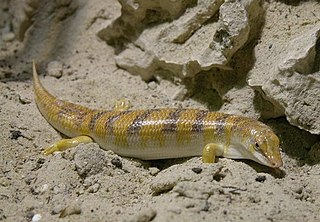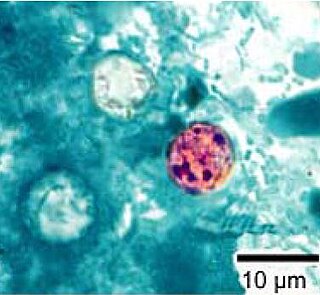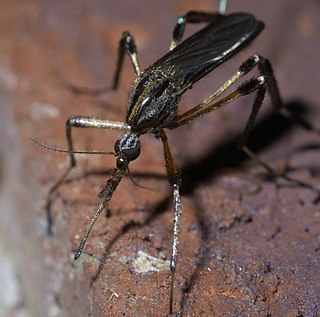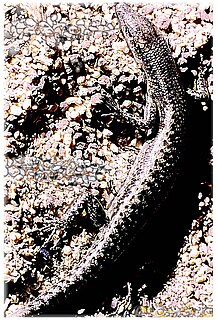Euprepis is an obsolete genus of skinks in the subfamily Lygosominae. It was named by Wagler in 1830 and frequently used in subsequent years, often misspelled as Euprepes, a misspelling introduced by Wiegmann in 1834. It was then subsumed under the large skink genus Mabuya, until Mausfeld and others resurrected it for a group of mainly African skinks they split from Mabuya. The following year, Bauer argued that this assignment had been in error and that this group should be called Trachylepis instead. Euprepis itself is a junior synonym of Mabuya.

Scincus is a genus of skinks, lizards in the family Scincidae. The genus contains four or five species, all of which are typical desert inhabitants, living in sandy and dune-like areas with a hot and dry climate. Species in the genus Scincus can be found from Arabia to the Sahara desert.

The broad-headed skink or broadhead skink is species of lizard, endemic to the southeastern United States.

Scincus scincus, also commonly known as the sandfish skink, common sandfish or common skink, is a species of skink notable for its burrowing or swimming behaviour in sand. It is native to the Sahara Desert and the Arabian Peninsula, but is also kept as a pet elsewhere.
The eastern skink, also commonly known as the Arabian sand skink and the eastern sand fish, is a species of lizard in the skink family (Scincidae).

Leiolopisma telfairii, also known commonly as the Round Island ground skink, the Round Island skink, and Telfair's skink, is a species of lizard in the family Scincidae. The species is endemic to Round Island, one of the islands of Mauritius.

Bojer's skink is a small species of skink, a lizard in the family Scincidae. The species is endemic to Mauritius including some of its offshore islands.
Chalcides minutus, or the small three-toed skink, is a species of skink found in Morocco and western Algeria. Its numbers are declining, but it is locally common. It is most often found in damp, sunny forests or grasslands with thick vegetation, but it can also be found in relatively dry areas, and its population is most likely decreasing. It is threatened by overgrazing and habitat destruction due to encroaching agricultural interests. Females of the species give birth to live young through ovoviviparity. Recent molecular studies have revealed that C. minutus could be a composite of species with individuals from the type locality forming long independent lineage and the remaining most closely related to Chalcides mertensi.

The Algerian three-toed skink is a species of "grass-swimming" skink with an elongated serpentine shape and reduced limbs. It is endemic to north-western Africa.

Gardiner's burrowing skink is a species of lizard in the family Scincidae. P. gardineri is the only species in the (monotypic) skink genus Pamelaescincus.

White's skink, also known commonly as White's rock skink, is a species of lizard in the family Scincidae. The species is endemic to Australia.

Cyclospora is a genus of apicomplexan parasites. It includes the species Cyclospora cayetanensis, the causative agent of cyclosporiasis. Members of Cyclospora are characterized as having oocysts with two sporocysts, each containing two sporozoites.

Psorophora ciliata is a species of large mosquito indigenous to the United States east of the continental divide. It is one of thirteen species of the genus that reside in the continental United States. The mosquito has been referred to as the “gallinipper” or “shaggy-legged gallinipper” due to its tendency for aggressive behavior.

Stegastes albifasciatus, known commonly as the whitebar gregory or white-banded gregory, is a damselfish of the family Pomacentridae native to the western Indo-Pacific. Its range extends from the Seychelles and Réunion to the Ryukyu Islands, the Tuamoto Islands, and New Caledonia, where it is found on reef flats, reef margins and lagoons on patches of rubble or reef rock with live corals, particularly in areas of moderate water movement.
Parazosmotes scincus is a species of beetle in the family Cerambycidae. It was described by Francis Polkinghorne Pascoe in 1865, originally under the genus Synelasma. It is known from Borneo.

Teratoscincus scincus, commonly referred to as the common wonder gecko or the frog-eyed gecko, is a species of lizard in the family Sphaerodactylidae. The species is native to arid parts of Asia and has special adaptations which suit it to desert life.

Cryptoblepharus boutonii, also known commonly as Bouton's snake-eyed skink, Bouton's skink, and the snake-eyed skink, is a species of lizard in the family Scincidae. The species is endemic to Mauritius, including nearby islets.
Spondylurus sloanii, also known commonly as Sloane's skink or the Virgin Islands bronze skink, is a species of lizard in the family Scincidae. The species is native to the United States Virgin Islands and the British Virgin Islands.
Scincus hemprichii is a species of lizard which is endemic to Yemen.













